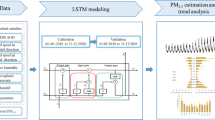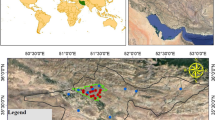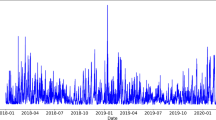Abstract
Air pollution, a pressing issue in Vietnam, is primarily caused by elevated levels of particulate matter 2.5 (PM2.5). Accurate PM2.5 forecasting is crucial for effective air quality management. This study uses advanced approaches, such as Long Short Term Memory (LSTM-based) models, to estimate PM2.5 levels in Vietnamese locations. Ten locations were initially chosen for prediction, but the pre-processing reduced the number to six due to missing critical values. The study constructs and rigorously tests prediction models using historical meteorological data with conventional statistical indicators. It also explores model combinations for increased reliability and acknowledges persistent problems in improving accuracy and real-world application. In conclusion, this work provides unique insights into PM2.5 forecasting, particularly the superior performance of the LSTM-based model, to aid in mitigating the causes of air pollution.
Q.-D. Nguyen and T. A. H. Nguyen—The first two authors contributed equally to this work.
Access this chapter
Tax calculation will be finalised at checkout
Purchases are for personal use only
Similar content being viewed by others
References
Ambient (outdoor) air pollution. https://www.who.int/news-room/fact-sheets/detail/ambient-(outdoor)-air-quality-and-health. Accessed 23 Jan 2024
Poor air quality recorded in capital city of Hanoi. https://en.sggp.org.vn/share106725.html. Accessed 24 Jan 2024
Vietnam Air Quality Index (AQI) and Air Pollution information — IQAir. https://www.iqair.com/vietnam. Accessed 20 May 2024
Pant, P., Huynh, W., Peltier, R.E.: Exposure to air pollutants in Vietnam: assessing potential risk for tourists. J. Environ. Sci. 73, 147–154 (2018). https://doi.org/10.1016/j.jes.2018.01.023
Minh, V.T.T., Tin, T.T., Hien, T.T.: PM2.5 forecast system by using machine learning and WRF model, a case study: Ho Chi Minh City, Vietnam. Aerosol Air Qual. Res. 21(12), 210108 (2021). https://doi.org/10.4209/aaqr.210108
Pruthi, D., Liu, Y.: Low-cost nature-inspired deep learning system for PM2.5 forecast over Delhi, India. Environ. Int. 166, 107373 (2022). https://doi.org/10.1016/j.envint.2022.107373
Doreswamy, Harishkumar, K.S., Yogesh, K.M., Gad, I.: Forecasting air pollution particulate matter (PM2.5) using machine learning regression models. Procedia Comput. Sci. 171, 2057–2066 (2020). https://doi.org/10.1016/j.procs.2020.04.221
Du, S., Li, T., Yang, Y., Horng, S.J.: Deep air quality forecasting using hybrid deep learning framework. IEEE Trans. Knowl. Data Eng. 33(6), 2412–2424 (2021). https://doi.org/10.1109/TKDE.2019.2954510
Chang, Y.S., Chiao, H.T., Abimannan, S., Huang, Y.P., Tsai, Y.T., Lin, K.M.: An LSTM-based aggregated model for air pollution forecasting. Atmos. Pollut. Res. 11(8), 1451–1463 (2020). https://doi.org/10.1016/j.apr.2020.05.015
Zeng, Y., Ma, X., Jin, N., Zhou, X., Yan, K.: Air quality forecasting with hybrid LSTM and extended stationary wavelet transform. Preprint, in Review (2021). https://doi.org/10.21203/rs.3.rs-357905/v1
Méndez, M., Merayo, M.G., Núñez, M.: Machine learning algorithms to forecast air quality: a survey. Artif. Intell. Rev. 56(9), 10031–10066 (2023). https://doi.org/10.1007/s10462-023-10424-4
Chai, T., Draxler, R.R.: Root mean square error (RMSE) or mean absolute error (MAE)? - Arguments against avoiding RMSE in the literature. Geosci. Model Dev. 7(3), 1247–1250 (2014). https://doi.org/10.5194/gmd-7-1247-2014
Brassington, G.: Mean absolute error and root mean square error: which is the better metric for assessing model performance? In: EGU General Assembly Conference Abstracts, p. 3574 (2017)
Willmott, C., Matsuura, K.: Advantages of the mean absolute error (MAE) over the root mean square error (RMSE) in assessing average model performance. Clim. Res. 30, 79–82 (2005). https://doi.org/10.3354/cr030079
Nguyen, G.T.H., La, L.T., Hoang-Cong, H., Le, A.H.: An exploration of meteorological effects on PM2.5 air quality in several provinces and cities in Vietnam. J. Environ. Sci. 145, 139–151 (2024). https://doi.org/10.1016/j.jes.2023.07.020
Suman: Air quality indices: a review of methods to interpret air quality status. Mater. Today Proc. 34, 863–868 (2021). https://doi.org/10.1016/j.matpr.2020.07.141
Kee, E., Chong, J.J., Choong, Z.J., Lau, M.: A comparative analysis of cross-validation techniques for a smart and lean pick-and-place solution with deep learning. Electronics 12(11), 2371 (2023). https://doi.org/10.3390/electronics12112371
Bui, Q.T., et al.: SFCM: a fuzzy clustering algorithm of extracting the shape information of data. IEEE Trans. Fuzzy Syst. 29(1), 75–89 (2021). https://doi.org/10.1109/TFUZZ.2020.3014662
Acknowledgments
The authors extended their gratitude to PAM Air for sponsoring the study and providing access to a complimentary air quality monitoring network, thereby enhancing the scope of this research. Dr. Tran Thanh Tu, a lecturer at the School of Biotechnology, International University, contributed valuable expertise and guidance, facilitating the successful execution of scientific conduct. This research is also supported by The central Interdisciplinary Laboratory in Electronics and Information Technology “AI and Cooperation Robot,” International University - Vietnam National University of Ho Chi Minh City.
Author information
Authors and Affiliations
Corresponding author
Editor information
Editors and Affiliations
Rights and permissions
Copyright information
© 2024 The Author(s), under exclusive license to Springer Nature Switzerland AG
About this paper
Cite this paper
Nguyen, QD. et al. (2024). Investigation of Machine Learning and Deep Learning Approaches for Early PM2.5 Forecasting: A Case Study in Vietnam. In: Nguyen, N.T., et al. Computational Collective Intelligence. ICCCI 2024. Lecture Notes in Computer Science(), vol 14810. Springer, Cham. https://doi.org/10.1007/978-3-031-70816-9_24
Download citation
DOI: https://doi.org/10.1007/978-3-031-70816-9_24
Published:
Publisher Name: Springer, Cham
Print ISBN: 978-3-031-70815-2
Online ISBN: 978-3-031-70816-9
eBook Packages: Computer ScienceComputer Science (R0)




